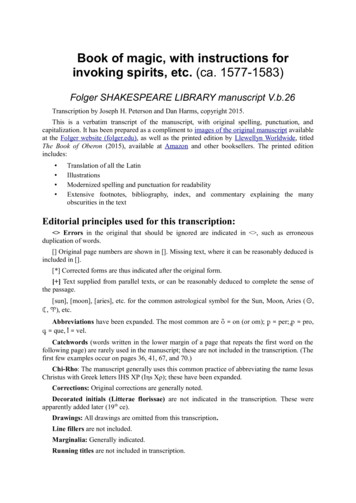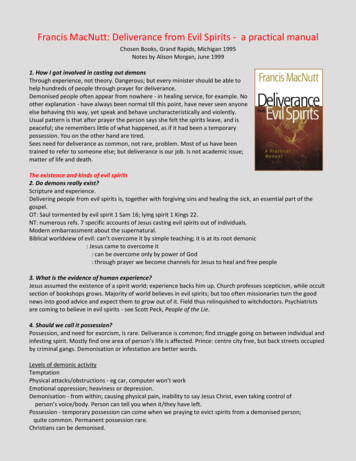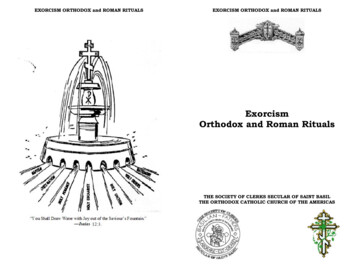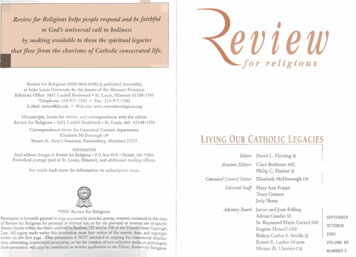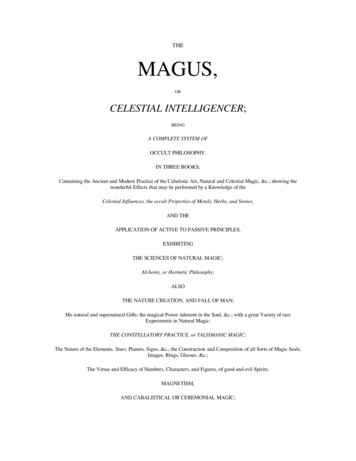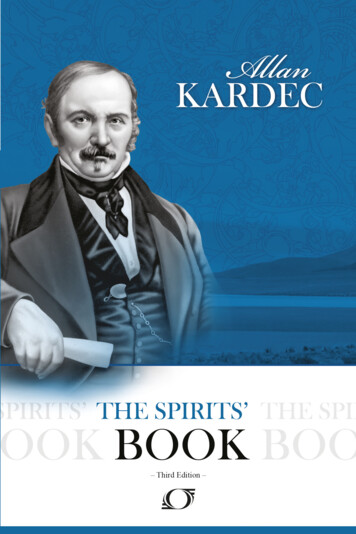
Transcription
THESPIRITS’ BOOK
Spiritualist PhilosophyTHESPIRITS’ BOOKContaining thePRINCIPLES OF THE SPIRITIST DOCTRINECONCERNING THE IMMORTALITY OF THE SOUL, THE NATURE OF SPIRITS ANDTHEIR RELATIONSHIPS WITH HUMANKIND, MORAL LAWS, THE PRESENT LIFE, THEFUTURE LIFE AND THE DESTINY OF HUMANITY – ACCORDING TO THE TEACHINGSGIVEN BY HIGHLY EVOLVED SPIRITS THROUGH SEVERAL MEDIUMS – RECEIVEDAND COORDINATEDByAllan KardecTranslated by Darrel W. Kimble with Marcia M. Saiz
Copyright 2006 byINTERNATIONAL SPIRITIST COUNCILSGAN Q. 909 – Conjunto F70790-090 – Brasilia (DF) – BrazilAll rights reserved. No part of this book may be reproduced by any mechanical,photographic, or electronic process, or in the form of a phonographic recording; normay it be stored in a retrieval system, transmitted, or otherwise be copied for public orprivate use without prior written permission of the publisher.ISBN 978-85-98161-18-1Original Title:LE LIVRE DES ESPRITS(PARIS, 1857)Translated by Darrel W. Kimble with Marcia M. SaizCover design by: Luciano Carneiro HolandaLayout: Rones José Silvano de LimaEdition ofINTERNATIONAL SPIRITIST COUNCILSGAN Q. 909 – Conjunto F70790-090 – Brasilia (DF) – Brazilwww.edicei.comedicei@edicei.com 55 61 3038-8400Sales: 55 61 3038 8425Third Edition 10/2011INTERNATIONAL DATA FOR CATALOGING IN PUBLICATION (ICP)K27gKardec, Allan, 1804-1869.The Spirits’ Book: Spiritualist Philosophy: Principles of the SpiritistDoctrine / by Allan Kardec; [translated by Darrel W. Kimble and MarciaM. Saiz]. – Brasilia, DF (Brazil): International Spiritist Council, 2011.578 p. ; 21 cm.Translated from: Le Livre des Esprits“Concerning the immortality of the soul, the nature of spirits and theirrelationships with humankind, moral laws, the present life, the future lifeand the destiny of humanity – according to the teachings given by highlyevolved spirits through several mediums”ISBN 978-85-98161-18-11. Spiritualism. 2. Spiritism. I. International Spiritist Council. II. Title.CDD 133.9CDU 133.7
ContentsTranslators’ Preface . 13Anna Blackwell’s Preface to Her Version.15Preface to the Revised Edition.25Introduction.27Prolegomena.73PART ONEFirst CausesChapter I – GodGod and the Infinite.79Proofs of the Existence of God.80The Attributes of the Divinity.82Pantheism.83Chapter II – The General Elements of the UniverseThe Knowledge of the Origin of Things.87Spirit and Matter.88The Properties of Matter.91Universal Space.93Chapter III – CreationThe Formation of Worlds.95The Formation of Living Beings.96The Peopling of the Earth: Adam.99The Diversity of Human Races.99
The Plurality of Worlds.100Biblical Considerations and Account concerning the Creation. 102Chapter IV – The Vital PrincipleOrganic and Inorganic Beings.107Life and Death.109Intelligence and Instinct.111PART TWOThe Spirit World or the World of SpiritsChapter I – SpiritsThe Origin and Nature of Spirits.117The Primitive Normal World.120The Form and Ubiquity of Spirits.120The Perispirit.122The Different Orders of Spirits.123The Spirit Hierarchy.124The Progression of Spirits.133Angels and Demons.138Chapter II – The Incarnation of SpiritsThe Purpose of Incarnation.141The Soul.142Materialism.147Chapter III – The Return from the Corporeal to the Spirit LifeThe Soul after Death; Its Individuality. Eternal Life.151The Separation of the Soul from the Body.153The Spirit’s State of Confusion after Death.157Chapter IV – The Plurality of ExistencesReincarnation.161The Justice of Reincarnation.162Incarnation on Different Worlds.163Progressive Transmigration.170The Fate of Children after Death.173
Gender in Spirits.175Kinship, Affiliation.176Physical and Moral Likeness.177Innate Ideas.181Chapter V – Considerations concerning the Plurality ofExistences. 183Chapter VI – Spirit LifeErrant Spirits.197Transitional Worlds.200Perceptions, Sensations and Sufferings of Spirits.203Theoretical Essay on Sensation in Spirits.208The Choice of Trials.215Relationships beyond the Grave.223Sympathies and Antipathies among Spirits. Eternal halves.227The Remembrance of Corporeal Existence.231The Commemoration of the Dead. Funerals.235Chapter VII – The Return to Corporeal LifePreludes to the Return.239The Joining of the Soul with the Body. Abortion.243The Moral and Intellectual Faculties of Humankind.247The Influence of the Organism.249Mental Impairment, Insanity.251Childhood.255Earthly Sympathies and Antipathies.258Forgetfulness of the Past.260Chapter VIII – The Emancipation of the SoulSleep and Dreams.267Visits between the Spirits of Living Persons.274The Concealed Transmission of Thought.276Lethargy, Catalepsy. Apparent Death.277Somnambulism.278Ecstasy.283Second Sight.285A Theoretical Summary on Somnambulism, Ecstasy andSecond Sight.287
Chapter IX – The Intervention of Spirits in the Corporeal WorldThe Reading of Our Thoughts by Spirits.295The Concealed Influence of Spirits upon Our Thoughtsand Actions.296The Possessed.300Convulsionaries.303The Affection of Spirits for Certain Persons.305Guardian Angels: Protector, Familiar and Sympathetic Spirits.306Presentiments.318The Influence of Spirits on the Events of Life.319The Action of Spirits on the Phenomena of Nature.324Spirits during Battle.326Pacts.328Occult Power, Talismans, Sorcerers.330Blessings and Curses.332Chapter X – Occupations and Missions of Spirits. 333Chapter XI – The Three KingdomsMinerals and Plants.343Animals and Human Beings.345Metempsychosis.354PART THREEMoral LawsChapter I – Divine or Natural LawThe Characteristics of Natural Law.361The Origin and Knowledge of Natural Law.362Good and Evil.366The Divisions of Natural Law.371Chapter II – The Law of WorshipThe Purpose of Worship.373Outward Worship Forms.374The Contemplative Life.376
Prayer.376Polytheism.380Sacrifice.382Chapter III – The Law of LaborThe Necessity of Labor.387The Limit of Labor. Rest.389Chapter IV – The Law of ReproductionThe Global Population.393The Succession and Perfection of the Races.393Obstacles to Reproduction.395Marriage and Celibacy.396Polygamy.397Chapter V – The Law of PreservationThe Self-Preservation Instinct.399The Means of Self-Preservation.399The Enjoyment of Material Things.403Necessary and Superfluous Things.404Voluntary Privation. Mortifications.405Chapter VI – The Law of DestructionNecessary Destruction and Abusive Destruction.409Destructive 418The Death Penalty.419Chapter VII – The Law of SocietyThe Need for Societal Life.423The Life of Isolation. The Vow of Silence.424Family Ties.425Chapter VIII – The Law of ProgressThe State of Nature.427The March of Progress.428
Relapsed Cultures .431Civilization.435The Progress of Human Legislation.437Spiritism’s Influence on Progress.438Chapter IX – The Law of EqualityNatural Equality.441The Inequality of Aptitudes.442Social Inequalities.443The Inequality of Wealth.443The Trials of Wealth and Poverty.445Equality of Rights between Men and Women.446Equality in Death.448Chapter X – The Law of FreedomNatural Freedom.451Slavery.452Freedom of Thought.454Freedom of Conscience.454Free Will.456Fatalism.458Foreknowledge of the Future.466A theoretical Summary on the Driving Force behind HumanActions.468Chapter XI – The Law of Justice, Love and CharityJustice and Natural Rights.473The Right of Ownership. Theft.476Charity and Love for Our Neighbor.477Maternal and Filial Love.480Chapter XII – Moral PerfectionVirtues and Vices.483The Passions.489Selfishness.490The Characteristics of a Moral Person.495Self-Knowledge.496
PART FOURHopes and ConsolationsChapter I – Earthly Joys and SorrowsRelative Happiness and Unhappiness.501The Loss of Loved Ones.508Disappointments. Ungratefulness. Broken Affections.510Antipathetic Unions.511The Fear of Death.513Dissatisfaction with Life. Suicide.514Chapter II – Future Joys and SorrowsNothingness. The Future Life.523The Intuition of Future Joys and Sorrows.524God’s Intervention in Punishments and Rewards.525The Nature of Future Joys and Sorrows.527Temporary Punishments.535Expiation and Repentance.538The Duration of Future Punishments.543The Resurrection of the Flesh.551Heaven, Hell and Purgatory.553Conclusion. 559
TRANSLATORS’ PREFACE TOTHE THIRD EDITIONThis third edition is a further refinement of the secondedition, which was a thorough revision of the first. Since thepublication of the first edition, we have translated and the I.S.C.has published the first editions of the other volumes of the SpiritistCodification – The Mediums’ Book (2006), Heaven and Hell (2006),The Gospel according to Spiritism (2008) and Genesis (2009) – aswell as the additional work What is Spiritism? (2010), and they willbe revised as new editions are published.In the first two editions, we made a few comments about howwe approached a number of grammatical issues and we will reiteratethem here. The authoritative French version was published in 1857,nearly 150 years ago. Apart from the challenge of translating fromone language into another and overcoming the structural differencesbetween the two, there were other challenges involving the timeperiod differential. The first and greatest of these challenges was theproblem of gender-neutral language. When referring to individuals,we addressed the problem by using plural pronouns as much aspossible because they are gender- neutral, rather than the singularpronoun combinations he or she, him or her, his or her. Whenreferring to a single spirit or soul, the neuter pronoun it was used,since, technically, spirits are sexless, though sometimes the singular13
Translators’ Prefaceform was changed to the plural; nevertheless, we used the personalrelative pronouns who and whom when referring to a single spirit orsoul. Masculine pronouns were eliminated when referring to God,because Spiritism does not hold to the idea that God should bepersonified; God is viewed as the First Cause (see question no.1),who works in creation strictly through established natural laws.Thus, the proper noun God was used to replace the pronouns. Inother instances, the singular man and all of its related pronouns wereusually changed by employing the plural humans, human beings,individuals, etc., which were also used to replace the plural men.Our main goal was to hold as closely to Kardec’s original aspossible without producing either a transliteration or a paraphrase,which is why we retained as many original terms as possible andadhered to the original style as much as the grammatical andstructural differences between the two languages would allow.This edition also includes Anna Blackwell’s Preface to herversion, which has served the English public since the 19th century.Her Preface contains a short biography of Allan Kardec, but wehave modified it slightly by updating it into modern English.We suggest that the reader who may be unfamiliar withSpiritism as coined and codified by Allan Kardec begin by perusing theTable of Contents to locate an area of particular interest – a questionconcerning reincarnation, prayer, the premature death of children, lifeafter death, etc. – and see how various high order Spirits (“the Spirits”)address the issue. This will lead to further interest, at which time thereader should begin with Kardec’s Introduction – essential for settingthe whole body of knowledge as revealed by the Spirits within theproper context – and from there work through the entire book.Darrel KimbleRio de Janeiro, Brazil 201014
ANNA BLACKWELL’S PREFACETO HER VERSIONUpdated into Modern Englishby the TranslatorsHippolyte Léon Denizard Rivail, better known by his penname, ALLAN KARDEC, was born in Lyons on October 4, 1804into an old family of Bourg-en-Bresse, which for many generationshad been honorably distinguished in the magistracy and at the bar.His father, like his grandfather, was an attorney of good standingand high character; his mother, who was remarkably beautiful,accomplished, elegant and amiable, was the object, on his part, ofa profound and worshipping affection that remained unchangedthroughout his entire life.Educated at the Institution of Pestalozzi in Yverdun (Cantonde Vaud), he acquired at an early age the habit of investigationand the freedom of thought of which his later life was destined tofurnish so striking an example. Endowed by nature with a passionfor teaching, he devoted himself from the age of fourteen to aidingthe studies of those of his schoolfellows who were less advancedthan himself. He was so fond of botany that he would often spendan entire day in the mountains, walking twenty or thirty mileswith a backpack in search of specimens for his herbarium. Born15
Anna Blackwell’s Preface to Her Versionin a Catholic country but educated in a Protestant one, as a mereboy he began to meditate on the means of bringing about a unityof belief among the various Christian sects – a project of religiousreform at which he labored in silence for many years but necessarilywithout success, since the elements of the desired solution werenot in his possession at the time.Having finished his studies at Yverdun, he returned to Lyonsat age 24 with the intention of devoting himself to law; however,various acts of religious intolerance, to which he unexpectedlyfound himself subjected, led him to renounce the idea of preparingfor the bar, and to take up residence in Paris, where he occupiedhimself for some time in translating Telemachus and other standardFrench books for youth into German. Having finally determinedwhat his career would be, in 1828 he purchased a large andflourishing educational establishment for boys and devoted himselfto the work of teaching, for which, by his tastes and acquirements,he was peculiarly suited. In 1830 and at his own expense he renteda large hall on Rue de Sèvres, where he offered courses consistingof free lectures on chemistry, physics, comparative anatomy, andastronomy. He continued these lectures over a period of ten years.They were highly successful and were attended by an audienceof over five hundred persons of every social class, many of whomhave since attained eminence in the scientific world.Always desirous to make education attractive as well asprofitable, he invented an ingenious method of computation, andconstructed a mnemotechnic table of French history for enablingstudents to remember the remarkable events and discoveries ofeach reign.Some of the numerous educational works he publishedwere: A Plan for the Improvement of Public Instruction, which hesubmitted in 1828 to the French Legislative Chamber, whichpraised it highly but took no action with regards to it; A Course16
Anna Blackwell’s Preface to Her Versionof Practical and Theoretic Arithmetic, on the Pestalozzian System,for the use of Teachers and Mothers (1829); A Classical Grammarof the French Tongue (1831); A Manual for the use of Candidatesfor Examination in the Public Schools with Explanatory Solutionsof various Problems of Arithmetic and Geometry (1848); NormalDictations for the Examinations of the Hotel de Ville and the Sorbonnewith Special Dictations on Orthographic Difficulties (1849). Theseworks were highly regarded at the time of their publication andare still in use in many French schools. Their author continuedto produce new editions of some of them at the time of his death.He was a member of several scholarly societies such as:The Royal Society of Arras, which awarded him with the Prizeof Honor in 1831 for a remarkable essay on the question, “Whatis the System of Study most in Harmony with the Needs of theEpoch?” For several years, he was Secretary to the PhrenologicalSociety of Paris, and took an active part in the labors of the Societyof Magnetism, giving much time to the practical investigationof somnambulism, trance, clairvoyance, and the various otherphenomena connected with mesmerism. The following briefoutline of his labors will suffice to show his mental activity, thevariety of his knowledge, the eminently practical turn of his mind,and his constant endeavor to be useful to his fellow humans.Around 1850, when the phenomenon of “table-turning”was grabbing the attention of Europe and ushering in the otherphenomena since known as “Spiritist”, he quickly divined the realnature of those phenomena as being evidence for the existence ofan order of relationships that had until then been suspected ratherthan known; i.e., those that unite the visible and invisible worlds.Foreseeing the vast importance to both science and religion of suchan extension of the field of human observation, he immediatelybegan a careful investigation of the new phenomena. A friendof his had two daughters, who had become what are now called17
Anna Blackwell’s Preface to Her Version“mediums”. They were carefree, lively, amiable girls, who werefond of socializing, dancing, and amusement. When “sitting” bythemselves or with their young companions, they habitually received“communications” in harmony with their worldly and somewhatfrivolous dispositions. However, to the surprise of all concernedit was discovered that whenever Kardec was present, the messagestransmitted through these young ladies acquired a very grave andserious character. When he asked the invisible intelligences whatcaused this change, he was told that, “spirits of a much higher orderthan those who habitually communicate through the two youngmediums have come expressly for you and will continue to do so inorder to enable you to fulfill an important religious mission.”Much astonished at such an unexpected announcement, heimmediately proceeded to test its truthfulness by drawing up aseries of progressive questions in relation to the various problemsof human life and the universe in which we find ourselves, andsubmitted them to his unseen interlocutors. He received theiranswers to these questions through the instrumentality of thetwo young mediums, who willingly consented to devote a coupleof evenings every week to this purpose, and who thus obtained,through table- rapping and planchette-writing, the replies thathave become the basis of the Spiritist theory, and which they wereas little capable of appreciating as of inventing.When these conversations had been going on for nearlytwo years, he remarked to his wife one day, in reference to theunfolding of these views, which she had followed with intelligentsympathy: “It is a most curious thing! My conversations with theinvisible intelligences have completely revolutionized my ideasand convictions. The instructions thus transmitted constitutean entirely new theory of human life, duty, and destiny, whichappears to me to be perfectly rational and coherent, admirablylucid and consoling, and intensely interesting. I have a great mind18
Anna Blackwell’s Preface to Her Versionto publish these conversations in a book, for it seems to me thatwhat interests me so deeply might very likely prove interestingto others as well.” His wife warmly approved of the idea, and sohe then submitted it to his unseen interlocutors, who replied inthe usual way that it was they who had suggested it to his mind;that their communications had been made to him, not for himselfalone, but for the express purpose of being given to the world ashe proposed to do; and that the time had now come for puttingthis plan into action. “To the book in which you will embody ourinstructions”, continued the communicating intelligences, “youwill give, as being our work rather than yours, the title Le Livre desEsprits (THE SPIRITS’ BOOK). You shall not publish it underyour own name, but under the pseudonym ALLAN KARDEC.1Keep your own name Rivail for your own books already published,but take and keep the name we have now given you for the bookyou are about to publish under our orders, and, in general, for allthe work that you will have to do to fulfill the mission, which aswe have already told you, has been confided to you by Providence,and which will gradually open before you as you proceed in itunder our guidance.”The book thus produced and published sold very quickly,winning converts not only in France, but all over the Continent,and making the name of ALLAN KARDEC “a household word”to the readers who knew him only in connection with it. Fromthat time onwards, he was called only by that name, except byhis old personal friends, with whom both he and his wife alwaysretained their family name. Soon after its publication, he foundedThe Parisian Society of Psychological Studies, of which he wasPresident until his death, and which met every Friday eveningat his house for the purpose of obtaining from spirits, throughwriting mediums, instructions in the elucidation of truth and duty.An old Breton name in his mother’s family.119
Anna Blackwell’s Preface to Her VersionUntil his death, he also founded and edited
THEIR RELATIONSHIPS WITH HUMANKIND, MORAL LAWS, THE PRESENT LIFE, THE . The Spirit World or the World of Spirits Chapter I – Spirits . Codification – The Mediums’ Book (2006), Heaven and Hell (2006), The Gos

